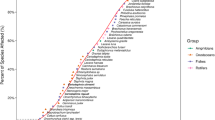Abstract
Cadmium concentration inNereis virens exposed to sediment spiked with cadmium increased linearly with time, no equilibrium concentration being indicated by 24 days of exposure. The concentration withinN. virens also increased with concentration of Cd in the sediment, and smaller worms accumulated higher amounts per unit weight than larger worms. With exposure to sediment containing 1 to 4 ppm Cd, accumulation rates ranged from 0.018 to 0.037μg Cd/g dry wt/hr for 1- to 2-g worms and from 0.014 to 0.024μg Cd/g dry wt/hr for 5- to 7-g worms.
N. virens exposed to 0.03 to 9.2 ppm Cd in sea water for 14 days had accumulation rates of 0.019 to 2.217μg Cd/g dry wt/hr for 1- to 2-g worms and 0.013 to 1.327μg Cd/g dry wt/hr for 5- to 7-g worms.
There was practically no excretion of cadmium forN. virens with initial concentrations of 5 to 20μg Cd/g dry wt during 75 days in clean conditions.
Sediment containing 1 and 4 ppm Cd produced concentrations of about 0.03- and 0.1-ppm cd in the overlying water. The accumulation rates from sediment with 1 and 4 ppm Cd are equal to the rates from sea water with 0.03 and 0.1 ppm Cd, respectively, indicating that cadmium uptake byN. virens is primarily from the aqueous phase.
Similar content being viewed by others
References
Benayoun, G., S. W. Fowler, and B. Oregioni: Flux of cadmium through euphausiids. Mar. Biol.27, 205 (1974).
Bryan, G. W.: The effects of heavy metals (other than mercury) on marine and estuarine organisms. Proc. Roy. Soc. London B,177, 389 (1971).
Dethlefsen, V.: Uptake, retention, and loss of cadmium by brown shrimp (Crangon crangon). Meeresforsch.26, 137 (1977/78).
Eisler, R.: Cadmium poisoning inFundulus heteroclitus (Pisces: Cyprinodontidae) and other marine organisms. J. Fish. Res. Board Can.28, 1225 (1971).
Hardisty, M. W., S. Kartar, and M. Sainsbery: Dietary habits and heavy metal concentrations in fish from the Severn Estuary and Bristol Channel. Mar. Poll. Bull.5, 61 (1974).
Holmes, C. W., E. A. Slade, and C. J. McLerran: Migration and redistribution of zinc and cadmium in marine estuarine system. Environ. Sci. Technol.8, 255 (1974).
Hutcheson, M. S.: The effect of temperature and salinity on cadmium uptake by the blue crab,Callinectes sapidus. Chesapeake Sci.15, 237 (1974).
Lu, J. C. S., and K. Y. Chen: Migration of trace metals in interfaces of sea water and polluted surficial sediments. Environ. Sci. Technol.11, 174 (1977).
Majori, L., and F. Petronio: Su un modelo semplificato per l'equilibrio dinamico di ripartizione dei metalli fra mitilo (Mytilus galloprovincialis LMK) e acqua marina. If fattore di accumulo. Igiene moderna66, 19 (1973). Fish. Mar. Serv. Transl. Ser. No. 3118.
Melhuus, A., K. L. Seip, H. M. Seip, and S. Myklestad: A preliminary study of the use of benthic algae as biological indicators of heavy metal pollution in Sorfjorden, Norway. Environ. Pollut.15, 101 (1978).
McLean, M. W., and F. B. Williamson: Cadmium accumulation by the marine red alga,Porphyra umbilicalis. Physiol. Plant.41, 268 (1977).
Nimmo, D. W. R., D. V. Lightner, and L. H. Bahner: Effects of cadmium on the shrimps,Penaeus duorarum, Palaemonetes pugio andPalaemonetes vulgaris, In F. J. Vernberg, A. Calabrese, F. P. Thurberg, and W. B. Vernberg (ed.): Physiological responses of marine biota to pollutants. p. 131. New York: Academic Press (1977).
Ray, D. G., and A. E. Brafield: The energy relations of the polychaete Neanthes (=Nereis)virens (SARS). J. Animal Ecol.42, 673 (1973).
Reish, D. J., and R. S. Carr: The effect of heavy metals on the survival, reproduction, development, and life cycles for two species of polychaetous annelids. Mar. Poll. Bull.9, 24 (1978).
Snow, D. R., and J. Marsden: Life cycle, weight, and possible age distribution in a populationNereis virens from New Brunswick. J. Natural History8, 513 (1974).
Thurberg, F. P., A. Calabrese, E. Gould, R. A. Greig, M. A. Dawson, and R. K. Tucker: Response of lobster,Homarus americanus, to sublethal levels of cadmium and mercury, In F. J. Vernberg, A. Calabrese, F. P. Thurberg, and W. B. Vernberg (ed.): Physiology responses of marine biota to pollutants, p. 185. New York: Academic Press (1977).
Ueda, T., R. Nakamura, and Y. Suzuki: Comparison of115mCd accumulation from sediments and sea water by polychaete worms. Bull. Jap. Soc. Sci. Fish.42, 299 (1976).
Vernberg, W. B., P. J. DeCoursey, M. Kelly, and D. M. Johns: Effects of sublethal concentrations of cadmium on adultPalaemonetes pugio under static and flow-through conditions. Bull. Environ. Contam. Toxicol.17, 16 (1977).
Westernhagen, H. Von, and V. Dethlefsen: Combined effects of cadmium and salinity on development and survival of flounder eggs. J. Mar. Biol. Ass. U.K.55, 945 (1975).
Zaroogian, G. E., and S. Cheer: Accumulation of cadmium by the American oyster,Crassostrea virginica. Nature261, 408 (1976).
Author information
Authors and Affiliations
Rights and permissions
About this article
Cite this article
Ray, S., McLeese, D. & Pezzack, D. Accumulation of cadmium byNereis virens . Arch. Environ. Contam. Toxicol. 9, 1–8 (1980). https://doi.org/10.1007/BF01055494
Received:
Accepted:
Issue Date:
DOI: https://doi.org/10.1007/BF01055494




